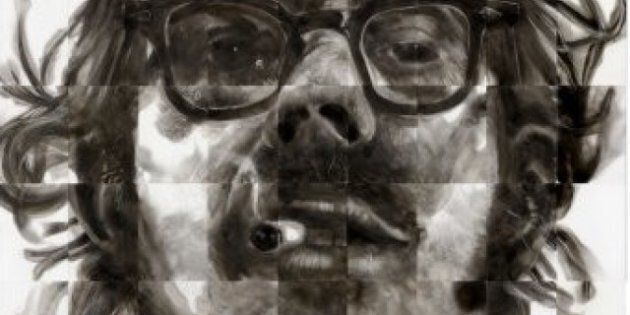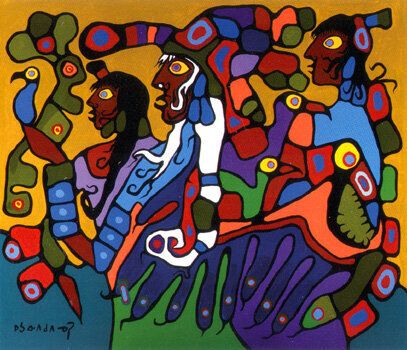
What if I told all you Loyalist and Tory art lovers out here on the East Coast, in Toronto, and Alberta that some ugly, alcoholic, Native bisexual was the greatest Canadian artist who ever lived? You might tell me to get stuffed.
This year Norval Morrisseau would have turned 80. He had Parkinson's disease and died in 2007 of cardiac arrest. The man was an enigma who left a legacy of paradoxes -- and art historians scrambling to clean up the mess. But who was this madman and why should we care?
These are questions writer James R. Stevens touches in his recent book, A Picasso in the North Country, The Wild Journey of Canadian Artist Norval Morrisseau. I should add here as a disclaimer that Jim is a friend, and I'm not inclined to write a review of a friend's work.
But this wasn't my first encounter with the famous artist. I'd met him a couple of times; once was just before the end when he was selling bad paintings in a Thunder Bay mall. The other was an uneventful encounter in the late 1960s in a friend's apartment in Thunder Bay.
Not too long after that first meeting, the friend, Ray Andrews, told me about riding with Morrisseau on a cross-town bus. Within a couple of minutes Morrisseau asked him out on a date. When Andrews laughed it off, Morrisseau waited until the next stop, pulled a long phallic rock out of his pocket, and offered it "as something to remember" him by before getting off the bus. The rock is long gone, but the story is another of the apocryphal tales that add to Morrisseau's mythology.
And it's Morrisseau's mythology that Stevens unravels with these stories, and in doing so brings a richer understanding of the artist's life that might have been otherwise lost. But the question remains, why would we view Morrisseau as the greatest artist?
There's the conventional story. Through the tangled wreckage of his art career -- which ends in art forgeries and a strange array of people caught up reshaping his legacy -- we can now see the complete picture, starting with his early work in earth tones guided by Selwyn Dewdney. Then the Toronto years with Jack Pollock and their acrimonious split. And finally his Vancouver years.
All of this is well documented along with several decades of drifting across the country and periodically retreating back to Northern Ontario, famously giving away paintings for bottles of booze. And the man knew he was a mythic figure; he bought into his own shamanistic reputation, managed it, and played it for all it was worth.

Canada has a deep catalogue of excellent artists, from British-born Fred Varley to realist Alex Colville to popular modernists Michael Snow and Jack Bush. And all of them worked hard to define the Canadian experience and bring it to the world. Christopher Pratt's barren landscapes and more recent barren nudes come to mind. Or Jack Chambers' The 401 Towards London. But these originate in a European or American tradition reapplied to defining who we are as Canadians, as seen under a microscope or through a long lens (which adds an odd bit of irony to Colville's stark binocular painting, To Prince Edward Island).
Others, like Emily Carr and Bill Reid, translated the Canadian experience through Aboriginal images and totems. And native Woodlands artists like Roy Thomas caught the form but entirely missed the message.
The same was true of many of Canada's artists of the day. Their work provides a valuable record of our natural history, geography, and cultural iconography, but little of it examines their own meaning in society. But Morrisseau went beyond looking at society -- which he chose not to explore -- and directly channeled his own inner Canadian experience.
Merging his early experiences from the residential school with later experiences living on the streets of Beardmore and Thunder Bay, Morrisseau became a human being on his own terms, and did what no other Canadian had done before him. He explored himself. Not as a Canadian, but as a man.
This is exactly what qualifies Morrisseau as Canada's greatest artist. He was the first Canadian to paint his country from the inside out -- not the outside in.
It was Morrisseau's vision of himself -- as us -- and not some cold-eyed gaze at his land or culture.
As Stevens' book tells us, here was a young man not afraid to dress up in drag and parade around one of the toughest logging towns in Northern Ontario in the early 1960s. Desperately poor, marginalized, unattractive, and strange, he asked, "Who am I?" To answer that, he adopted the fish and animals he'd seen on petroglyphs and painted his own in black and sepia in his now famous X-ray style.
When his mentor and adviser Selwin Dewdney tried to hold him to that style, Morrisseau rebelled, as he would again and again. He evolved. His work began to include self-portraits and wild colours. He became the child in the Madonna's arms. He became the man with the exposed penis and garish feathers in the stained glass paintings. One doesn't need a diagram to understand the origins of these images.
But motivation matters. And ultimately, in both life and in art, Morrisseau's insatiable "I want" cravings drove him from a Métis kid born to the rubbish heap, to international art superstar, to tragic figure.
In the end Stevens wisely dismisses the notion of Morrisseau as a shaman. Morrisseau was what we acknowledge him to be, a true artist.
Today's artists such as playwright Tomson Highway and performance artist Rebecca Belmore owe much to Morrisseau. We all do. John Ralston Saul alludes to this in A Fair Country when he points out that we are all Métis. As has the National Gallery's curator Greg Hill, who formally reclaimed Morrisseau as an equal in the pantheon of Canadian greats.
Yes, Norval Morrisseau was a flawed human being. Yet he is who we are, if we have the heart and the eyes to see. But buyer beware. His work is still so powerful that one piece can easily dominate an entire house.